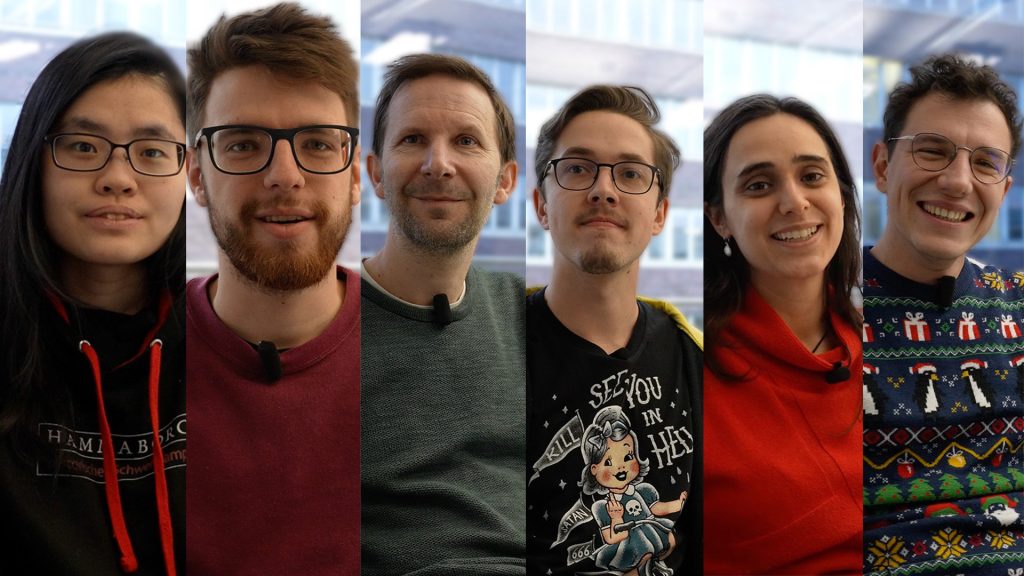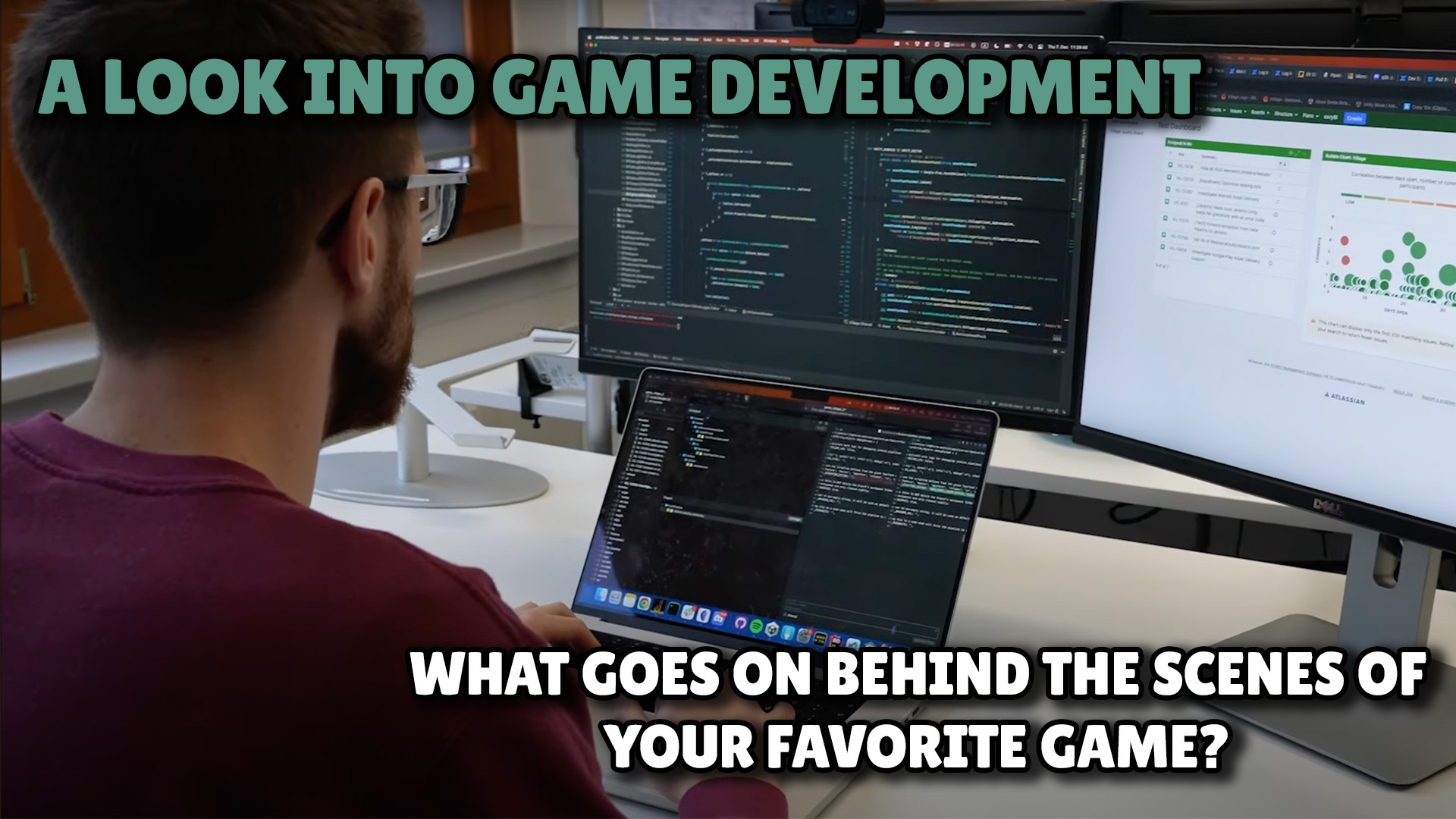Have you ever wondered what goes on behind the scenes of your favorite game? Curious to know how it all plays out when a group of passionate and skilful people combine their forces to bring something new and exciting to life? Or maybe you yourself are dreaming of creating your own game or working in the gaming industry. Whatever fuels your curiosity, we have the answers for you today! We recently had the pleasure of sitting down with some of the team members behind Sunrise Village for a “Meet the Team” video series, and today we want to share with you some of the insights of how they experience working on Sunrise Village.
So meet Johannes(Front-end developer), Leon (unity Developer), Martina (game designer), Rachael (3D Artist ) and Paul (apprentice developer), and continue reading to learn about how they help build Sunrise Village.
And if you’re interested in seeing the full-length interviews you can watch the whole video series on our official Sunrise Village Youtube

Roles and Responsibilities
Every game you play is the result of a diverse group of people,working together like cogs in a machine, and contributing their unique skills to create the final product.
Take Martina, for instance As a Game Designer whose passion is crafting the very stages and storylines that players immerse themselves in, Martina’s day involves dreaming up the quests, challenges, and adventures that form the backbone of the game.
It’s her job to ensure that these stories are not only fun but also resonate with players on a deeper level.
Meanwhile, Rachel brings the game’s world to life with her models and animations. Whether it’s a cozy village house, a towering tree, or a simple rock, Rachel’s work adds depth and realism to the environments you explore.
Leon and Paul, as Unity Developers, spend their days turning the game designers’ ideas into functional and visually appealing features, configuring the game’s user interface, implementing exciting new features, and ironing out those pesky bugs.
For Johannes, a Front-end Developer, the focus is on what you, the player, actually see and experience. From creating smooth user interfaces to optimizing performance across various devices, Johannes is dedicated to ensuring that everything you interact with in the game feels intuitive and seamless.
And then there’s Andreas. As a Technical Artist, Andreas acts as the bridge between the art team and developers. His job is all about ensuring that the game looks stunning on any device. Whether it’s crafting intricate shaders or troubleshooting the inevitable bugs, Andreas is the one who makes sure that what you see on screen is nothing short of magical.
The Challenges of Crafting a Game
But game development isn’t all smooth sailing. Each role comes with its own set of challenges. For Andreas and Johannes, the biggest hurdle is often technical—ensuring that the game performs well on every device, no matter how powerful or limited. Balancing performance with visual quality is a constant juggling act.
Collaboration in large teams, as Leon and Paul point out, also presents its challenges. With so many moving parts, clear communication and alignment are key. Even something as seemingly simple as using the same version control system (like Git) can become a complex task when several people are involved.
Then there’s the challenge of learning new tools and adapting to different workflows, something Rachel knows all too well. She tells us she used to do freelancing and moving to a structured game development environment required her to quickly get up to speed with Blender and Unity—tools she hadn’t used before. It’s a testament to her adaptability and dedication that she’s now an integral part of the team.
Martina’s challenges are more on the creative side. For her, the hardest part is finding that “sweet spot” where a game is not only fun to play but also engaging and meaningful. There’s no right or wrong answer when it comes to game design, which means that every new feature or quest is a leap into the unknown, guided by experience and a deep understanding of what players might enjoy.
The Joy of Creation
Of Course we also had to ask the team what they love the most about their work, and they all agree that despite these challenges, there’s a deep sense of satisfaction that comes from seeing the fruits of their labor come to life.
Andreas and Rachel both find joy in the art style and visuals of the game. Andreas, in particular, loves how the detailed yet stylized graphics contribute to the overall feel of the game, while Rachel has a soft spot for the game’s intro sequence, which she finds warm and charming.
For Martina, the joy comes from storytelling. She loves crafting the narrative that guides players through their adventures, especially the ongoing quest to find and reunite the crystals—a storyline that she finds both original and engaging.
And although there are challenges in working in a team, Leon and Paul both followed up with a show of appreciation for the team dynamics. Leon appreciates the diversity and scale of the team, which he feels adds a richness to the development process. Paul adds to this, highlighting the supportive and collaborative atmosphere, which has been crucial as he navigates the challenges of being a newcomer and an apprentice.
Johannes, ever the explorer, finds excitement in the game’s endless content. Whether it’s the Rifts or other exploratory features, he loves that there’s always something new to discover and that his work directly contributes to these experiences.
Personal Growth and Connection
Beyond the technical and creative aspects, working on a game is also about personal growth and connection. Paul speaks about his journey as an apprentice, learning the ropes and gradually gaining confidence in his abilities. Rachel, too, reflects on her transition from freelance work to a more structured role in game development, and the satisfaction that comes from mastering new tools and techniques.
There’s also a deep sense of pride that comes with seeing their work appreciated by players. Martina, for example, finds fulfilment in seeing players engage with the stories and quests she designs. Knowing that her work brings joy to others and helps create a unified, immersive experience is what makes all the challenges worth it.
For some, the connection is even more personal. Paul, for instance, shares a story about how his mother, a big fan of the game, loves discussing it with him. It’s a reminder that behind every game are real people, with families and friends who play and enjoy the worlds they help create.
Conclusion: The Magic of Teamwork
Now you know more about what goes on behind the scenes of Sunrise Village and game development. In the end, it’s a journey filled with creativity, challenges, and a deep sense of purpose to create something that resonates with players around the world.
For those of you aspiring to join this industry, remember that it’s not just about mastering the tools or learning the latest techniques. It’s about collaboration, adaptability, and a passion for creating experiences that others will love. Whether you’re dreaming of becoming a game designer like Martina, a 3D artist like Rachel, or any other role within the industry, know that you’re stepping into a world where your creativity and skills can truly shine.
So, as you embark on your own journey into game development, take a moment to appreciate the hard work and dedication that goes into every game you play. Because behind every pixel, every line of code, and every quest, there’s a team of passionate individuals working tirelessly to bring a little bit of magic into your life.

